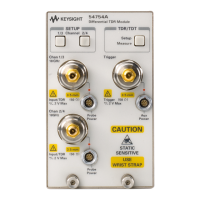Care and Handling of Precision Connectors
3.5 mm Connector Care
2-3
3.5 mm Connector Care
This chapter shows you how to take care of 3.5 mm connectors so that you can
maintain high levels of accuracy, repeatability, and system performance. Taking
appropriate care of your connectors will also extend their service life. Most of
the information can also be applied to 2.4 mm connectors. For additional
information on 2.4 mm connectors, refer to operating note "2.4 mm Adapters
and Calibration Accessories" HP part number 11900-90903.
Connector Wear
Connector wear will eventually degrade performance. The calibration devices,
which are typically used only a few times each day, should have a very long life.
However, because the connectors often undergo many connections a day, they
wear rapidly. Therefore, it is essential that all connectors on the HP 54753A or
HP 54754A TDR plug-in modules be inspected regularly, both visually (with a
magnifying glass) and mechanically (with a connector gage), and replaced as
necessary. Procedures for visual and mechanical inspection are given in the
next section of this manual. It is easier and cheaper to replace a worn adapter
than a worn channel connector.
Operator Skill
Operator skill in making good connections is essential. The mechanical
tolerances of the precision 3.5 mm connectors used in the HP 54007A kit are
two or three times better than the tolerances in regular 3.5 mm connectors.
Slight errors in operator technique that would go unnoticed with regular
connectors often appear with precision connectors in the calibration kit.
Incorrect operator technique can often result in lack of repeatability. Carefully
study and practice the connection procedures that are explained later in this
manual until your calibration measurements are consistently repeatable.
Device Specifications
Electrical specifications depend upon several mechanical conditions. A 3.5 mm
connector is a precision connector dedicated to very specific tolerances. SMA
connectors are not precision mechanical devices. They are not designed for
repeated connections and disconnections and are very susceptible to

